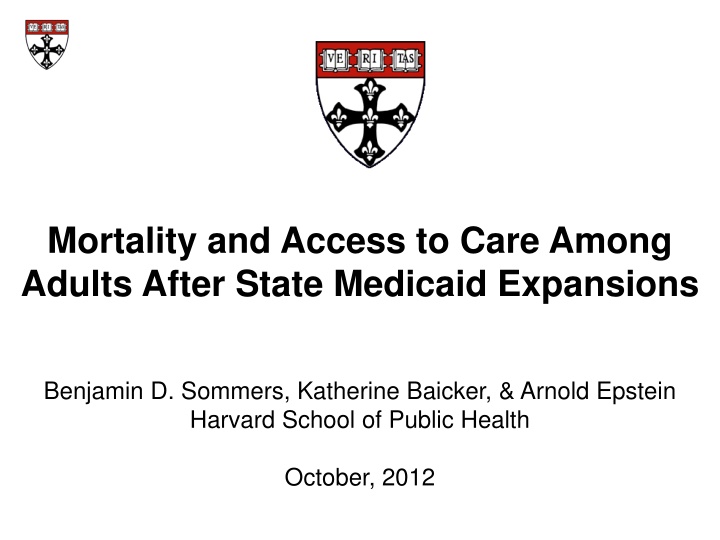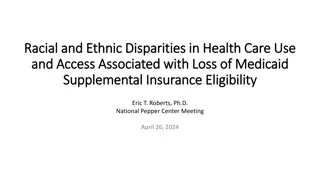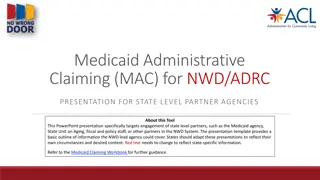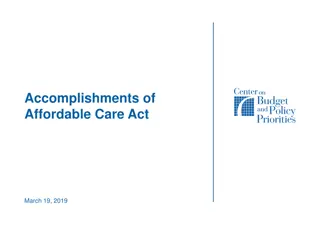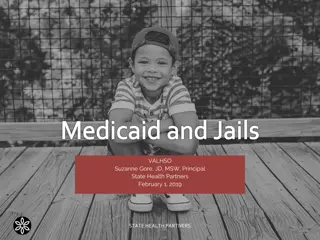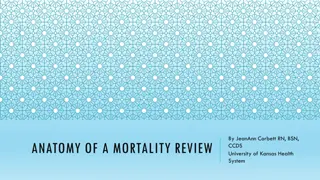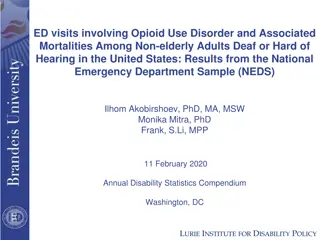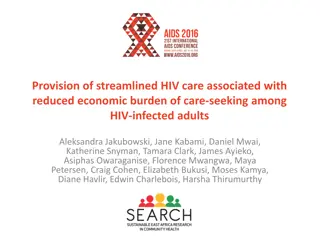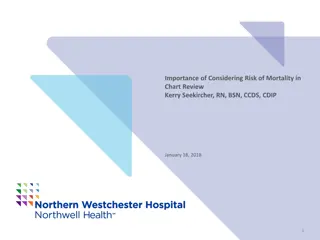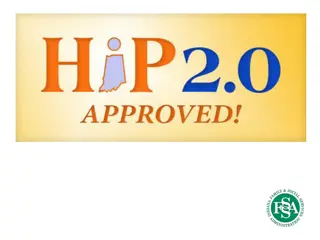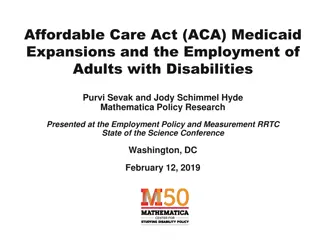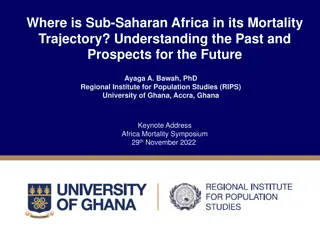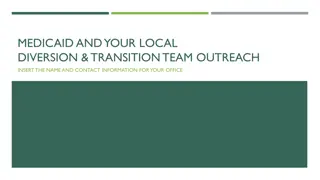Impact of State Medicaid Expansions on Mortality and Access to Care Among Adults
The study explores the effects of state Medicaid expansions on all-cause mortality, insurance coverage, access to care, and self-reported health among adults. By comparing states that expanded Medicaid to those that did not, the research aims to shed light on the impact of such policy decisions.
Download Presentation

Please find below an Image/Link to download the presentation.
The content on the website is provided AS IS for your information and personal use only. It may not be sold, licensed, or shared on other websites without obtaining consent from the author.If you encounter any issues during the download, it is possible that the publisher has removed the file from their server.
You are allowed to download the files provided on this website for personal or commercial use, subject to the condition that they are used lawfully. All files are the property of their respective owners.
The content on the website is provided AS IS for your information and personal use only. It may not be sold, licensed, or shared on other websites without obtaining consent from the author.
E N D
Presentation Transcript
Mortality and Access to Care Among Adults After State Medicaid Expansions Benjamin D. Sommers, Katherine Baicker, & Arnold Epstein Harvard School of Public Health October, 2012
Background The Affordable Care Act (ACA) expands Medicaid in 2014 to all adults up to 133% of the federal poverty level Recent Supreme Court ruling determined that states have the option of whether to participate in expansion Governors and legislators in several states have said they will not implement the expansion while many others have said they are reluctant to do so. 2
Background Reasons given by states that they will not expand Medicaid include: They oppose the ACA and won t implement any of it They can t afford it a threat of financial ruin Because it is a broken program Meanwhile, several states have already expanded Medicaid to adults over the past decade 3
Background Reasons given by states that they will not expand Medicaid include: They oppose the ACA and won t implement any of it They can t afford it a threat of financial ruin Because it is a broken program Meanwhile, several states have already expanded Medicaid to adults over the past decade Yet the health impact of Medicaid coverage is unclear, particularly for adults 4
Objectives To examine whether state Medicaid expansions were associated with any changes in all-cause mortality Secondary outcomes: insurance coverage access to care self-reported health 6
Methods We identified 3 states that expanded Medicaid to childless adults between 2000-2005: NY, Maine, Arizona We compared them to neighboring states with similar populations and no Medicaid expansion 7
Study States Treatment States 1) NY 2) ME 3) AZ Control States 1) PA 2) NH 3) NM & NV 8
Primary Outcome: Mortality All-Cause Mortality: County-level mortality by race, age, and gender from the Centers for Disease Control & Prevention (CDC) Time Period: 1997-2007, for 5 years before and after each expansion Study Sample:Adults ages 20 to 64 9
Other Outcomes Insurance: % with Medicaid coverage, % uninsured, from Census Bureau s Current Population Survey Access to Care: % experiencing cost- related barriers to care, from CDC s Behavioral Risk Factor Surveillance System Self-Reported Health: % in excellent or very good health 10
Methods - Briefly Our analysis adjusted for factors includingrace, age, sex, county, and local economic conditions Important because our analysis unlike Oregon is not randomized, so other differences between states could affect our results 11
Results: Medicaid EXPANSION STATES CONTROL STATES 15% 10% Percent of Non- Elderly Adults Enrolled in Medicaid 5% 0% -4 -3 Years before/after state Medicaid expansion -2 -1 0 1 2 3 4 5 12
Results: Uninsured EXPANSION STATES CONTROL STATES 25% 20% Percent of Non- Elderly Adults Who Are Uninsured 15% 10% 5% 0% -4 -3 -2 -1 0 1 2 3 4 5 Years before/after state Medicaid expansion 13
Results: Cost-Related Barriers 16.00 14.00 12.00 Percent of Non- Elderly Adults Delaying Medical Care Due to Cost 10.00 EXPANSION STATES 8.00 CONTROL STATES 6.00 4.00 2.00 0.00 Pre-Expansion Post-Expansion 14
Results: Self-Reported Health EXPANSION STATES CONTROL STATES 75% 70% Percent of Non- Elderly Adults in Excellent/Very Good Health 65% 60% 55% 50% -5 -4 -3 -2 -1 0 1 2 3 4 5 Years before/after state Medicaid expansion 15
Results: Mortality EXPANSION STATES CONTROL STATES 400 350 300 250 Deaths per 100,000 Non- Elderly Adults 200 150 100 50 0 -4 -3 -2 -1 0 1 2 3 4 5 Years before/after state Medicaid expansion 16
Multivariate Analyses Outcome Post-Expansion Absolute Change (Treatment vs. Control) Post-Expansion Relative Change (Treatment vs. Control) P-value Medicaid +2.2 percentage points +24.7% 0.01 Uninsured -3.2 percentage points -14.7% <0.001 Cost-Related Barriers to Care -2.9 percentage points -21.3% 0.002 Excellent or Very Good Health +2.2 percentage points +3.4% 0.04 All-Cause Mortality -19.6 deaths per 100,000 -6.1% 0.001 17
Which Groups Benefited? The decline in the death rate was significant for both whites and non-whites, but was twice as high among non-whites Medicaid was associated with larger health gains for older adults (35-64) and for people living in poorer areas All of this is consistent with whom we might expect to benefit most from a Medicaid expansion 18
Discussion Medicaid expansions were associated with significant reductions in mortality over a five-year follow-up period Pathway of secondary outcomes: Coverage Access Health Survival Consistent with gains in access and self- reported health in Medicaid from the randomized trial in Oregon 19
Limitations Results driven by largest state (New York), unclear how generalizable results may be Lack of individual-level information (especially health and chronic diseases) in mortality data Non-randomized design Results can only show an association Other unmeasured trends could be producing the observed results 20
Policy Implications Expanding Medicaid may, simply put, save lives These state expansions are quite similar to what states are considering under the ACA, though the latter expansions would be even bigger Would all states see the same benefits? 21
Cost: The Missing Piece Our data sources do not allow us to measure costs Oregon findings and other research suggests people with insurance will use more services and cost more 22
Cost: The Missing Piece But Medicaid remains less expensive than most private insurance Federal share of the ACA expansion is quite generous, and some state spending will be offset by reductions in uncompensated care 23
Conclusions Medicaid expansions are associated with improved coverage, access, health, and reduced mortality Expanded Medicaid under the ACA may significantly improve health for millions of low-income adults Cuts in Medicaid or repealing the Medicaid expansion likely would adversely impact the health of vulnerable populations 24
Acknowledgments Many thanks to my co-authors Arnie Epstein and Kate Baicker at the Harvard School of Public Health 25
